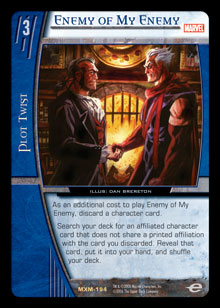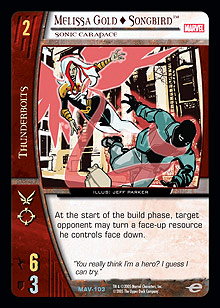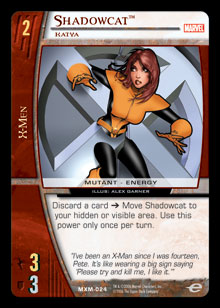Here in Atlanta, beatdown is king. Of the top ten decks from Day 1, nine were aggressive strategies ranging from the obsessively homicidal burn deck piloted by Jesse Hill to the swarming X-Faces deck employed by four of the top-10ers. Squadron also had a big showing, matching X-Faces with four spots in the top ten. All hope is not lost for dedicated control players; Nile Rowland navigated the late-game powerhouse that is Hellfire to an 8-2 record and 5th place.
Patrick Richardson, 9-1, 1st place after Day 1
Characters:
4 Ape X, Xina
4 Joystick
4 Shape, Malleable Mutant
4 Melissa Gold ◊ Songbird, Sonic Carapace
3 Lady Lark, Linda Lewis
2 Lady Lark, Skylark
4 Golden Archer
1 Hawkeye, Leader by Example
3 Albert Gaines ◊ Nuke
3 Genis-Vell ◊ Photon
 Plot Twists:
Plot Twists:
4 Panacea Potion
4 Answer the Call
4 Flying Kick
3 Other-Earth
2 Enemy of My Enemy
Locations:
2 Rocket Central
Equipment:
4 Thunder Jet
3 Airskimmer
2 Framistat
Squadron was the most played deck at the PC, and it did not disappoint. The deck is ludicrously powerful, taking advantage of the synergy between reservist characters and a potent empty-hand strategy. Squadron plays 1-drops that can take down 3-drops, 2-drops that tangle with 4’s, all the way up to the 5-drop 13 ATK / 11 DEF monster that is Albert Gaines ◊ Nuke. Under-costed characters like Joystick, Shape, Malleable Mutant, Melissa Gold ◊ Songbird, and Lady Lark, Linda Lewis are backed up by great utility creatures. Golden Archer often hits for ten on turn 4, initiative or no, while Hawkeye, Clinton Barton’s ability to stun weenies is often pivotal against other off-curve decks. A great suite of characters is backed up by an equally impressive collection of plot twists, locations, and equipment, all designed to help the Squad player empty his or her hand. Panacea Potion gives the Squad player an extra guy to swing with on his or her initiative and, often, can help steal the opponent’s: no one likes swinging through Albert Gaines twice. Most of the other plot twists, locations, and equipment in Squad focus on killing the opponent. Other-Earth and the formation-breaking Flying Kick help Squadron’s high-powered characters to breakthrough for massive endurance loss, while Thunder Jet, Image Inducer, and Rocket Central allow Squadron to jump-the-curve even more effectively, assuring stuns on both offense and defense. Character search cards round out most Squad lists. Answer the Call and Enemy of My Enemy ensure that the Squad player has a steady flow of the right characters.
Patrick Richardson piloted a teched out version of the deck to 1st place at the end of Day 1. In addition to the typical character suite, Richardson ran Lady Lark, Skylark and Genis-Vell ◊ Photon. Skylark’s auto-recovery effect is especially helpful against other off-curve strategies, giving the Squadron player an extra man, or woman in this case, to help keep the opposing swarm in check. If there’s one thing opponents don’t expect out of a Squadron deck, it’s defensive plot twists, and Genis-Vell’s ability to be pitched for +2 DEF makes him a great surprise in the early game. The fact that he’s a 14 ATK / 12 DEF reservist with flight and range doesn’t hurt either.
Richardson wasn’t the only Squad player packing tech. Kyle Dembinski (8-2, 9th place after Day 1) ran Quagmire, Jerome Meyers, a 1- drop that doubles as a searchable mini-Nasty Surprise and Null Time Zone to help restrict his opponent’s options. Ryan Jones (8-2, 10th place after Day 1) injected a little extra burn into his build of Squadron, running Electric Eve, Toxin, and the suicidal Firestar, Hellion to help eliminate those last few endurance points.
Of the four Squad players in the Top 10, only one, Dembinski, ran Whizzer. Having a built in Press the Attack is ridiculous, but, in a format full of 13 ATK / 11 DEF Albert Gaines and Avengers/Brotherhood decks packing Heroes in Reserve, Boot to the Head, and Avengers Mansion, Whizzer will most likely stun on his first attack. He also lacks reservist, turning him into a liability if drawn in the early game. He does shine against the X-Faces deck; aided by an Other-Earth, he can often swing for the full eighteen against Day 1’s most successful deck.
Anthony Justice, 9-1, 2nd place after Day 1
 Characters:
Characters:
1 Viper, White Warrior Princess
1 Ape X, Xina
2 Cannonball, Blast Field
4 Archangel, Angel
2 Dallas Riordan, Mayoral Aide
2 Speed Demon, Second Chance Speedster
2 Melissa Gold ◊ Songbird, Sonic Carapace
1 Plant Man ◊ Blackheart
1 Ogre, Weaponsmith
1 Joystick
1 Beetle ◊ Mach 1
1 Nathan Garrett ◊ Black Knight, Corrupt Crusader
1 Radioactive Man, Chen Lu
1 Gargantua
1 Paul Ebersol ◊ Fixer
4 Yellowjacket, Rita Demara
4 Beetle, Armorsmith
1 Marcus Daniels ◊ Blackout
1 Melter, Bruno Horgan
1 Shocker, Vibro-Shock Villain
1 Melissa Gold ◊ Screaming Mimi, Mimi Schwartz
Plot Twists:
4 Faces of Evil
4 Hard Sound Construct
4 Mob Mentality
3 Mystic Summons
3 Null Time Zone
1 Brave New World
1 X-Men United
Locations:
4 X-Corp: Amsterdam
1 Stormfront-1
Equipment:
1 Blackbird Blue
Before PC Atlanta, decks based around Faces of Evil were generally discounted as viable options for Marvel Modern Age. It was felt that the loss of the nutty Dr. Light, Master of Holograms and the card-drawing power of Birthing Chamber would severely hinder such a swarm-oriented strategy. It turns out that the rumors of Faces’ demise were greatly exaggerated. The recovery-themed X-Men were the perfect team to resuscitate the supposedly dead Faces deck, providing X-Faces with almost limitless access to its marquee plot twist.
Like the Faces deck played by the Aussies at PCLA, X-Faces works by recruiting a large number of small characters, all designed to maximize the attack bonus provided by Faces of Evil. Beetle, Armorsmith and Yellowjacket, Rita Demara allow the deck to ensure an endless stream of small weenies, each with unique abilities designed to counter anything the opponent might throw at them. The game usually ends on an explosive turn 5 or 6, with a multitude of little men swinging for far too much damage, backed up by a double-attack from Speed Demon, Second Chance Speedster.
The X-Men team’s most important additions to the deck are X-Corp: Amsterdam and Archangel, Angel. Archangel’s ability to fetch out an X-Corp, which in turn can fetch Faces of Evil, means that an X-Faces deck like Anthony Justice’s has approximately twelve virtual copies of Faces of Evil. If we include Beetle, Armorsmith, Yellowjacket, Beatle ◊ Mach 1, Viper, White Warrior Princess and Blackbird Blue (which the X-Faces player can fetch with Ape X) in our list of Faces substitutes, the number of “Faces” in the deck jumps to an astounding twenty-five. All those faces allow for ludicrously large 1 and 2-drops capable of taking down 4 or 5-drops, often without assistance.
X-Faces also packs a wide variety of utility characters and plot twists. Marcus Daniels ◊ Blackout and X-Men United help to keep the X-Faces player alive until that critical turn 5 or 6. In the past, Hawkeye, Clinton Barton has been the thorn in the foot of Faces, often capable of stunning two characters even when the Faces player has the initiative. X-Faces combines Brave New World and Mob Mentality to help solve the problem, turning their entire board into an untargetable mass of Physical Mutants, and transforming Hawkeye into a mediocre 4-drop with a small butt.
Unlike most decks in the format, X-Faces wants the even initiative, preferring to stall on turn 5 before exploding on turn 6. Shocker’s ability to stun other small characters, such as Joystick or Lady Lark, allows the X-Faces player to steal the initiative and limit the opponent to a single attack. The deck’s ability to go toe-to-toe with Squadron’s early aggression made it an excellent choice against the expected field.
The Squadron match-up, however, is far from a blow out. The X-Faces players I talked to put their winning percentage against Squadron at around 60%; Other-Earth on turn 5 represents a huge problem, nullifying X-Faces’ stalling reinforcement strategy.
In any case, those same X-Faces players are quick to point out that their deck was the best choice for PC Atlanta, and the numbers from Day 1 seem to agree with them.
Jesse Hill, 8-2, 6th place after Day 1
 Characters:
Characters:
4 Electric Eve, Live Wire
4 Jubilee, Jubilation Lee
4 Roulette, Hellion
4 Shadowcat, Katya
4 Bevatron, Hellion
4 Xorn
4 Bishop, XSE Commando
4 Golden Archer
4 Firestar, Hellion
1 Gambit, Ragin’ Cajun
Plot Twists:
4 Insect Swarm
4 Phase Shift
4 Cryonic Grenade
4 Feel the Burn
4 The Evil Eye
3 Enemy of My Enemy
If any deck can challenge X-Faces’ status as Day 1’s most successful deck, it is Jesse Hill’s “Burn” deck with its 80% match-win percentage. Hill was the only player at Atlanta to play the deck, and he was rewarded with an 8-2 record good enough for 6th place.
As the name suggests, the deck revolves around aiming damage directly at its opponents head, almost bypassing that little thing called combat. Much of the Burn deck’s burn involves the Energy trait introduced in The X-Men, allowing Roulette to supplement the fire offered by most of the decks other characters – Electric Eve, Jubilee, Jubilation Lee, Bevatron, Bishop, XSE Commando, Golden Archer, and Firestar, Hellion. Firestar is the preferred drop when the deck does not have the initiative on turn 5; between stun-back damage and her KO effect, she often deals ten to the opponent. If Burn has the initiative on 5, it can recruit Gambit, Ragin’ Cajun, whose ability to stun a 3-drop helps the deck deal those last few points of endurance loss.
The majority of Burn’s plot twists – Insect Swarm, Cryonic Grenade, Feel the Burn, and The Evil Eye – supplement the direct endurance loss theme of the deck’s characters. Phase Shift counts as an Energy card, allowing it to help fuel Roulette, Bevatron, and Gambit in their burning endeavors.
The deck is extraordinarily single-minded, focused entirely on reducing the opponent’s endurance to zero. It does not pack “answers” or “utility cards.” Enemy of My Enemy is the only card in the deck that cannot cause endurance loss, but it’s only in the deck to help Hill draw the characters he needs to kill his opponent. Based on his success on Friday, we can all be thankful Surprise Attack isn’t in the format.
Niles Rowland, 8-2, 5th place after Day 1
Characters:
4 Courtney Ross
4 Sage, Tessa
4 Mastermind, Dark Dreamer
3 Tarot
4 Madelyne Pryor
3 Empath
4 Shinobi Shaw
1 Donald Pierce
1 Magneto, Black Lord
2 Sebastian Shaw
Plot Twists:
4 Join the Club!
4 Army of One
4 Power and Wealth
3 Deadly Game
4 Shrink
2 System Failure
1 Power Play
1 Null Time Zone
Locations:
4 Shaw Industries
3 The Hellfire Club
In a format dominated by beatdown, Niles Rowland stands alone as the only control player in the top ten after Day 1. His “Hellfire Club” deck looks to stall the game until turn 7, when it can steal the initiative with Power Play and beat up the opponent with two attacks from Sebastian Shaw.
Hellfire Club plays very much like a fixed version of the “X-Statix” decks played at the last Marvel Modern Age PC in Amsterdam. It has a similar “loner” strategy; instead of controlling only one character like X-Statix, Hellfire Club wants to have only one visible character. Unlike X-Statix, Hellfire Club has excellent character, plot twist, and location search. Join the Club! allows Rowland to find all but seven of his characters, ensuring that he hits his curve beginning on turn 2 with the draw-smoothing, card-cycling Sage, Tessa. Power and Wealth involves a steep investment, having you exhaust two characters, but it allows Rowland to find any card in his deck (if he needs a specific character, he can always search up a Join the Club!). The versatility offered by Power and Wealth lets Rowland run a number of “silver bullets” in his deck. Cards like System Failure, Null Time Zone, and the initiative-stealing Power Play can all be fetched just when they are most needed.
Shaw Industries and The Hellfire Club, combined with a format in which DEF-boosting plot twists are a rarity, mean that Rowland does not have to play any other offensive plot twists. As a result, Rowland can stuff his deck with those aforementioned, unexpected DEF boosters like Army of One and Shrink which, combined with Shaw Industries, make game-breaking, failed attacks a real possibility.
Like X-Faces, Hellfire Club wants the even initiatives. The deck wants Shinobi Shaw’s large butt – 12 with the +1 ATK / +1 DEF counter he gets whenever he defends alone in the visible area and the +2 ATK / +2 DEF bonus he gets from Shaw Industries – to soak up enough endurance loss for the game to go turn 6, at which point Hellfire Club can drop an extremely large Donald Pierce (16 ATK / 16 DEF if he is alone in the visible area with a Shaw Industries) or more versatile Magneto, Black Lord. Both, with the help of Shaw Industries, Army of One, and Shrink, can attack most of the format’s six drops without stunning. This translates into minimal endurance loss on turn 6. On turn 7, Power Play allows Rowland to steal the initiative, leaving Sebastian Shaw to attack twice using his readying ability. With most decks in the format not even running 7-drops, Hellfire Club’s chances for victory go up exponentially if the game progresses to the later turns.
The presence of so many concealed characters in Hellfire can translate into a lot of early endurance loss. Courtney Ross helps, but, X-Faces or Squadron’s uber-aggressive starts can often kill the Hellfire player before he or she has time to set up the proper defenses. Character count is key for the deck; Sebastian Shaw, Power Play, Power and Wealth, and Shaw Industries all require multiple characters in the concealed area to be effective. As such, the successful Hellfire player must weigh the need to keep his or her character count up with the need to make sure the opponent’s swarm does not become too large.
Hellfire, like most control decks, is harder to play correctly than a deck like Squadron. As Niles Rowland’s success proves however, the deck can reward strong play with strong results. Hellfire’s wealth of DEF-boosting plot twists punishes opponents who are sloppy with their math or too aggressive in their attacks. If beatdown isn’t your style but you still want a deck that can run with the likes of Squad or X-Faces, Niles Rowland has provided us all with a solid alternative for the evolving metagame of Marvel Modern Age.
One deck that failed to live up to hype going into PC Atlanta was reservist. Avengers, Brotherhood, and Avengers/Brotherhood strategies all failed to perform as well as many players expected. In the end, it seems that Squad’s huge men and X-Faces’ swarms of untargetable, supercharged weenies proved too much for the reservist curve decks played by almost a third of this weekend’s competitors. It will be interesting to see if any tweaks can be made to the various reservist decks to allow them to compete more effectively in the upcoming PCQ season.